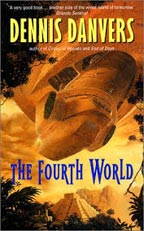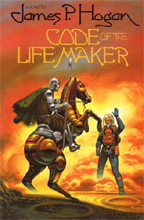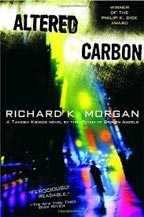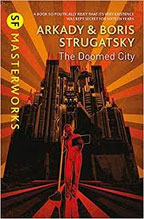Sharp and Pointed
The See Sharp Press Blog
October 24th, 2013
What exactly does “anarchist science fiction” mean? Stories written by anarchists? Stories with anarchist characters? Stories with anarchist settings? Stories that make anarchist political and social points? Stories with an “anarchist sensibility” (whatever that is)? Stories that anarchists will simply enjoy? All of the above? Who knows…..
Because of this, I’ve taken a somewhat expansive approach and have included a number of non-anarchist political sci-fi novels in this list simply because I think anarchists would enjoy them. They comprise maybe a third of the total. I’ve added brief comments about books I’ve read recently and those that particularly stand out in memory. I’m still adding to the list, which is far from complete – it’s simply a list of books I’ve read and that I recommend. (I’ve included a couple that I don’t particularly like, but included anyway because they are specifically anarchist or part of a series; in the comments preceding or following the titles, I’ve noted them.)
If you notice that any of your anarchist sci-fi favorites are missing from this list, please leave a comment mentioning them.
Here’s the list — the links go to reviews on this site.
Margaret Atwood
- The Handmaid’s Tale (1985). More speculative social fiction than science fiction, The Handmaid’s Tale is Atwood’s horrifying vision of what would happen to America, and especially American women, if fundamentalists seized power. Antiauthoritarian, but not specifically anarchist.
- Oryx and Crake (2003). The first book in the Maddaddam trilogy. An all too plausible, very well written look at the possible horrors of genetic engineering warped by profit-at-any-price corporate capitalism in a class-stratified, repressive sociopolitical system. It’s impressive in that it projects how current political, social, and technological trends in the U.S. and Canada (Atwood is Canadian) could develop and interact in coming decades; this is in sharp contrast to most sci-fi novels which will consider at most one such trend, and more often none.
- The Year of the Flood (2009). The second book of the trilogy. Just as entertaining as Oryx and Crake, it deals with the same political, social, and technological issues, but also features an in-depth depiction of life inside a religious/ecological cult.
- Maddaddam (2013). The final book in the trilogy. Just as engrossing as the previous two books, it adds a fair bit of material on the sleaziness and hypocrisy of fundamentalist religion, and much more on the extreme measures necessary to avoiding detection in a nearly all-seeing surveillance society.
Paolo Bacigalupi
- The Windup Girl (2009). Beautifully written. Probably the best cautionary tale about corporate-controlled genetic modification and control of food sources. Antiauthoritarian and anti-corporatist, but not specifically anarchist. (Note: friends in the life sciences tell me that Bacigalupi is quite inaccurate in some biological specifics, that he’s every bit as inaccurate here as he is in portraying climate change in the Southwest in his otherwise very good The Water Knife. Yes, these are cautionary tales, but gross exaggeration is gross exaggeration, and it tends to undercut the cautionary message. Still, these are both so well written and entertaining that I highly recommend them.)
Iain M. Banks
The following are Banks’ “Culture” novels–space opera on a grand scale. While set in the same universe, all work as stand-alone novels. All are set in a galaxy-spanning, far-future anarchist and atheist society, and all feature strong, believable characters (including AIs), complicated ethical dilemmas, and frequent dark humor. Of them, the two best are probably Player of Games and Surface Detail, and the weakest is probably The Hydrogen Sonata.
- Consider Phlebas (1987)
- The Player of Games (1988)
- Use of Weapons (1990)
- Excession (1996)
- Inversions (1998)
- Look to Windward (2000)
- Matter (2008)
- Surface Detail (2010)
- The Hydrogen Sonata (2012)
Another of Banks’ sci-fi novels worth your time is
- Transition (2009). It’s a parallel-worlds tale which deals with a wide range of social and political problems, ranging from the character deformation endemic to capitalism, to power-grubbing within hierarchies, to the question of whether the ends ever justify the means. The first half of the book is hard to follow, made up of disparate, apparently unrelated strands from the p.o.v. of different characters, but the tale eventually coalesces and concludes quite satisfactorily.
Christopher Brown
- Tropic of Kansas (2017). A gritty alternative-timeline story, with distinct anarchist overtones, of survival and resistance in an even more brutal and authoritarian present-day USA.
John Brunner
- The Sheep Look Up. (1972) Probably the best early science fiction novel about the environmental crisis; antiauthoritarian, but not anarchist.
Several of Brunner’s other sci-fi novels are also enjoyable, particularly Shockwave Rider (1975) and The Crucible of Time (1983). (But don’t pick up one of Brunner’s novels at random and expect a good read — his output was very uneven.)
Dennis Danvers
- The Fourth World (2000). An intermediate-future novel set in the southern Mexico of the Zapatistas, and a very good — borderline great — book that deserves to have sold much better than it did.
- The Watch (2003). A time travel novel set in Richmond, Virginia, featuring Peter Kropotkin as the primary character. An accurate portrayal of Kropotkin and his ideas, but not particularly engaging, in part because Danvers presents Kropotkin (in line with his actual character) as quite saintly and unconflicted, which isn’t a great prescription for the primary character in a novel.
Cory Doctorow
- Walkaway (2017). An intelligent, in places funny, near-future novel about the emergence of a post-scarcity anarchist society in the shadow of the “default reality” corporatist surveillance state.
- Radicalized (2019). Not a novel, but rather a collection of four novellas (rather three novellas and a longish short story) dealing with the near future and such things as the treatment of refugees, the “Internet of Things,” healthcare, systemic racism through the lens of (yes) a superhero, and a fortified bunker for the super-rich in times of chaos. The tales are uniformly well written and emotionally affecting. This is probably Doctorow’s best book to date.
Many of Doctorow’s other sci-fi works are also enjoyable reads. One I’d recommend is The Great Big Beautiful Tomorrow (2011).
Greg Egan
- Distress (1995). A hard sci-fi novel with pointed political and social commentary, largely set on an artificial island called “Stateless.” If you’re looking for a detailed description of how an anarchist society might operate, this isn’t it, but Distress is worth reading nonetheless.
- The Four Thousand, The Eight Hundred (2016). An all too timely cautionary tale about xenophobia, demagoguery, scapegoating, and persecution of minorities. Not explicitly anarchist, but antiauthoritarian.
El Akkad, Omar
- American War (2017). Not anarchist, and only implicitly antiauthoritarian, American War is almost certainly the best fictional depiction of the psychological and physical devastation caused by America’s interventionist wars, and the hatred and terrorism they engender.
Mick Farren
- Their Master’s War (1987). Antiauthoritarian but not anarchist. A page-turner concerning militarism, imperialism, and religious manipulation.
- The Armageddon Crazy (1989). An antiautoritarian, at times very funny, and all-too-relevant novel about a fundamentalist takeover of the U.S. government.
(These are Farren’s two best sci-fi novels, and the only two I’d unreservedly recommend.)
Harry Harrison
- The Stainless Steel Rat Gets Drafted (1987).On the surface, this book seems to be escapist sci-fi, but it’s actually a well thought out political novel that perceptively treats mutualist anarchism and nonviolent resistance. Almost certainly the best book in the Stainless Steel Rat series.
Robert Heinlein
- The Moon is a Harsh Mistress (1966). Deals with an anarcho-capitalist society on the moon at odds with an authoritarian Earth.
James P. Hogan
- Voyage from Yesteryear (1982). Features a setting directly derived from Murray Bookchin’s Post-Scarcity Anarchism. Not Hogan’s best book — it pales in comparison with Code of the Lifemaker — but worth reading nonetheless.
- Code of the Lifemaker (1983). Hogan’s very funny tale of science versus religious fanaticism is a nearly forgotten gem; not anarchist, but antiauthoritarian.
- The Immortality Option (1995). The sequel to Code of the Lifemaker; it’s also worth reading, but be sure to read Code of the Lifemaker first.
Ursula Le Guin
- The Left Hand of Darkness (1969). Leguin’s classic novel on gender relations.
- The Dispossessed (1974). Considered by many the classic anarchist sci-fi novel, its backdrop, for half of the book, is an anarchist society set on the planet Anarres. That society is well drawn, though dryly and unflatteringly (at least in my opinion; others would disagree).
Of Le Guin’s many other novels, the one I’d most recommend is The Lathe of Heaven (1971), which holds up well nearly half a century after it appeared.
Ken Macleod
The first four novels are set in the same universe, but are not parts of a series. The next three are a loose trilogy.
- The Star Fraction (1995)
- The Stone Canal (1996). The setting is an anarcho-capitalist society.
- The Cassini Division (1998). The setting is an anarcho-communist society.
- The Sky Road (1999)
- Cosmonaut Keep (2000)
- Dark Light (2001)
- Engine City (2002)
- The Night Sessions (2008). A cautionary tale of religious fanaticism
- Intrusion (2012). A frighteningly plausible dystopian novel of an all-pervasive surveillance state. A modern 1984.
- Corporation Wars: Dissidence (2016)
- Corporation Wars: Insurgence (2016)
- Corporation Wars: Emergence (2017)
Paul J. McAuley
Antiauthoritarian but not anarchist, these two novels comprise McAuley’s “Quiet War” series. They’re set in the medium-distant future following ecological collapse on Earth, and concern the brutal aggression of the authoritarian empires that emerged from the chaos against the in-some-ways anarchistic “Outers” who have colonized the moons of Jupiter and Saturn. There are two later novels set in the same universe, In the Mouth of the Whale (2012) and Evening’s Empires (2013). These are largely stand-alone novels. In the Mouth of the Whale is best avoided (very slow reading), but Evening’s Empires is a pretty decent apolitical quest/revenge tale.
Many of McAuley’s other science fiction novels are worth reading. Two that come to mind are Pasquale’s Angel and White Devils.
Richard K. Morgan
- Altered Carbon (2002). The first of a brutal, noirish trilogy with distinct anarchist undertones.
- Broken Angels (2003). The second in the series.
- Woken Furies (2005). The third book in the series.
- Market Forces (2004). An overtly political projection of the future of corporate capitalism.
- Thirteen (2007). A very dystopian look at a future theofascist USA.
Morgan’s most recent sci-fi novel, Thin Air (2018), is worth a read. It’s less political than the Altered Carbon series, though its tone is similar.
Annalee Newitz
- Autonomous (2017). Deals with the underestimated dangers of the corporate stranglehold on “intellectual property,” the horrors it could lead to, and possible forms of resistance to it.
Claire North
- 84K (2018). A well written, brutal dystopian tale about capitalism taken to its logical extreme (slavery — maximizing profits by minimizing labor costs). 84K is definitely not anarchist and is very short on solutions, but it does provide a gut-wrenching depiction of the emotional and physical carnage that seems all too possible should authoritarian capitalism continue careening downhill into the neoliberal chasm.
Nicholas P. Oakley
- The Watcher (2014). Explores primitivism, the role of technology in society, and consensus decision making. (Full disclosure: See Sharp Press published this one.)
George Orwell
- Animal Farm (1945). Orwell’s satirical critique of stalinism.
- 1984 (1949). Dreary and depressing – as it’s intended to be – but essential. Orwell’s projection of the logical progression of stalinism.
Eliot Peper
- Bandwidth (2018). A thought-provoking near-future thriller about online manipulation (basically Facebook on steroids), the climate change crisis, and whether the ends, no matter how noble, ever justify the means.
Marge Piercy
- Woman on the Edge of Time (1976)
Mike Resnick
- A Hunger in the Soul (1998). Set in a barely disguised Africa, this is probably the best sci-fi treatment of the psychology of colonialism. Not anarchist, but well worth a read. If you haven’t read Joseph Conrad’s Heart of Darkness (1898) or his perhaps even better short story, “An Outpost of Progress” (1897), reading them would be good preparation before plunging into A Hunger in the Soul.
Alastair Reynolds
- Revelation Space (2000)
- Chasm City (2001).
The “Revelation Space” novels comprise a fairly loose series set on and around a far future world featuring direct electronic democracy, human-machine integration, uplifted animals, class stratification, and orbiting habitats with a vast array of social structures. All of the books in the series work as stand-alone novels.
One of the sequels, The Prefect (2007), is worth reading sheerly for its entertainment value, as is the recent Elysium Fire (2018). It features the same cast of characters as The Prefect, and is a tightly written tale of murder, mystery, and revenge.
Kim Stanley Robinson
- Lucky Strike (2009). A fine if short parallel-universes novella on the morality of “just following orders.” This is Robinson at his best.
A number of readers have suggested including Robinson’s novels here, especially the “Mars” trilogy (Red Mars [1992]; Green Mars [1993]; Blue Mars [1996]). I haven’t done so simply because this is a list of anarchist and anarchist-related novels that I would recommend, and I’m not a fan of Robinson’s Mars books or most of his other novels. The two I would recommend (neither related to anarchism) are Galileo’s Dream (2009) and Aurora (2015). Those interested in possible political developments in China might also want to check out Robinson’s Red Moon (2018).
Rudy Rucker
The “ware” books comprise a very funny short tetralogy (written before the average sci-fi novel bloated to 700 pages) set in part against the backdrop of a sympathetically portrayed anarchist mechanoid society on the moon. The first two books in particular are gems.
- Software (1982)
- Wetware (1988)
- Freeware (1997)
- Realware (2000)
Rucker is also a great short story writer: many of his tales are both mind-bogglingly strange and brimming with laugh-out-loud, sometimes-crude humor. His Complete Stories (2012) runs to over a thousand pages, and perhaps his two best non-“ware” humorous novels (it’s hard to pick) are The Sex Sphere (1983) and Master of Space and Time (1984).
John Shirley
- Bioshock Rapture (2012). This novel is a prequel to the popular Bioshock video game. It’s of interest because it concerns the development of a cloistered Objectivist (Ayn Randist) society. Shirley does a good job of outlining some of the horrors that such a society would produce, but the worst horrors he describes are produced by the cloistering, which undercuts the critique of Objectivism as such. As well, because he was essentially in a straitjacket when he wrote this, Shirley incorporates fantastical elements from the game that are unnecessary from a fictional standpoint and that detract from the novel’s power. But it’s worth reading anyway.
Norman Spinrad
- The Iron Dream (1972). Alternately chilling and darkly funny, The Iron Dream’s premise is that Hitler emigrated to the U.S. in the 1920s, became a science fiction illustrator, and wrote a single sci-fi novel: The Iron Dream. The bulk of Spinrad’s book is comprised of the “manuscript” of that “novel,” and is an excellent illustration of the ugliness of the authoritarian psyche.
Many of Spinrad’s other antiauthoritarian sci-fi novels, such as Greenhouse Summer (1999) and He Walked Among Us (2009), both of which concern the ecological crisis, are also worth reading, as is his recent oft-times humorous political genre bender (sci-fi/fantasy) The People’s Police (2017). Getting somewhat away from sci-fi, Mind Game (1980) is Spinrad’s insightful treatment of a barely disguised Church of Scientology, and probably the best novel about cults ever written.
Charles Stross
- Singularity Sky (2003). A military sci-fi/time-travel tale that features anarchist characters in an authoritarian setting.
- Iron Sunrise (2004). The sequel to Singularity Sky.
- Glass House (2006). A suspenseful, brutal tale about gender roles and conformity.
- The Apocalypse Codex (2012). One of Stross’s genre-bending, amusing Laundry Files series, The Apocalypse Codex deals with a televangelist, his literally brain dead followers, and tentacled Lovecraftian horrors. Its treatment of both the absurdity and deadly menace of Christian fundamentalism is spot on.
- Neptune’s Brood (2013). A strange, sometimes funny story about the structure of interstellar finances and financial fraud. Part of the book is set in a sympathetically portrayed deep sea anarchist society of genetically modified humans.
- The Rhesus Chart (2014). Another entertaining Laundry Files novel. The Rhesus Chart deals with the big banks, and has a clear, concise explanation of exactly how they’re screwing us.
- The Delirium Brief (2017). This latest Laundry Files novel has privatization schemes as its backdrop, and contains an admirably concise explanation of how such schemes rob the public to the benefit of the rich and the corporations they control. (A Note on the Laundry Files books: While they can be read as stand-alone novels, they’re a lot more fun to read if you read them in order, starting with The Atrocity Archives [2004]).
- Empire Games (2017). The first book in the new “Merchant Princes” trilogy, Empire Games deals in large part with an even-more-overtly repressive, surveillance-state USA than our current pseudo-democratic nightmare. Stross provides enough background information that Empire Games works as a stand-alone novel, but for the inconclusive ending.
- Dark State (2018). The same comments apply to Dark State, the second book in the new trilogy. The third and final book, Invisible Sun, was originally scheduled for January 2019, has been delayed several times, and is now scheduled for March 2020.
Stross’s work is antiauthoritarian, though anarchism is treated overtly only in Neptune’s Brood. Almost all of his other books, particularly Halting State (2007), Rule 34 (2011), and nearly all of the Laundry Files novels are excellent reads.
Arkady and Boris Strugatsky
- The Doomed City (2016). A bleak, brutal, indirect dissection of the Soviet Union and the ideology that produced its horrors. Written in 1972, the brothers Strugatsky kept this novel under wraps for over 15 years until it was finally published in Russian in 1989 during perestroika; at long last it’s now available in English. Unfortunately, the English-language version reads very roughly, as it’s quite probably an overly literal translation.
- The Snail on the Slope (2018). A new translation of another Strugatsky classic dealing in large part with the insanity and inanity of Soviet-style bureaucracy. Much shorter than The Doomed City, with shallower criticism of the Soviet system, but an easier read. Again, the translation reads quite roughly.
Of the Strugatskys’ many other sci-fi novels, the two I’d most recommend are their two most popular: Roadside Picnic (1971) and Hard To Be a God (1964). Both are more coherent and much more entertaining than the two novels listed above, which are primarily of political interest. (I’d recommend the older translations of both books: the recent translations read too roughly due almost certainly to excessive literalism. Because of this, the older versions of the Strugatsky’s works read much more smoothly than the newer, too literal translations, and are much more enjoyable.)
George Turner
- Drowning Towers (UK title: The Sea and Summer)(1987). Drowning Towers was the first major novel about climate change and is still one of the best, if not the best. It’s not anarchist and barely antiauthoritarian, but it is acutely class conscious and a literary masterpiece.
- Brain Child (1991). A chilling and plausible look at a possible result of the use of genetic engineering to produce a race (actually three races) of ubermenschen. It still holds up.
The quality of Turner’s science fiction novels (he was also a literary novelist) was uneven, but mostly good and sometimes great. Drowning Towers and Brain Child are by far his best books. His final two sci-fi novels, Genetic Soldier (1994) and Down There in Darkness (1999) are decidedly subpar, with the latter being downright awful. (I suspect Turner’s publisher patched together fragments of an incomplete novel.) All of Turner’s other sci-fi novels (plus one short story collection, A Pursuit of Miracles [1990]) are well worth a read.
T.C. Weber
- Sleep State Interrupt (2016). A near-future noirish techno-thriller about combatting the surveillance state, and the first book in the BetterWorld trilogy. (Full disclosure: See Sharp Press published this one.)
- The Wrath of Leviathan (2018). The second book in the trilogy. The concluding volume, Zero-Day Rising, is scheduled for release in March 2020.
Robert Anton Wilson and Robert Shea
- The Illuminatus Trilogy (1975). More fantasy than science fiction, this hallucinogenic, sprawling mess of a trilogy veers wildly from the unreadable to the unparalleled, featuring sex, drugs, multiple first-person narrators, shifting chronology, stream-of-consciousness narrative, conspiracies on steroids, self-mockery, zombie Nazis, one of the funniest parodies of Ayn Rand’s capitalist-fantasy/romance novels ever written (“Telemacchus Sneezed,” featuring “John Guilt”), and occasional insightful comments on anarchism.
For those who’ve read and enjoyed The Illuminatus Trilogy, we’d also recommend Wilson’s Schroedinger’s Cat Trilogy (1979).
Yevgeny Zamyatin
- We (1924). Written by one of the first Soviet dissidents (within the Communist Party), this dreamy, nightmarish, poetic novel of an all-controlling police state is the direct forerunner of 1984.

Related Posts
- Positive Science Fiction: Iain M. Banks’ “Culture” Novels
- Notable Atheist Science Fiction Novels
- Mick Farren’s Sci-Fi Novels
* * *
Zeke Teflon, who compiled this list, is the author of Free Radicals: A Novel of Utopia and Dystopia, which takes place in part in an anarchist community. He’s currently working on the sequel in his copious free time.
Related articles

















